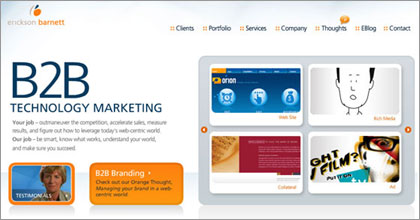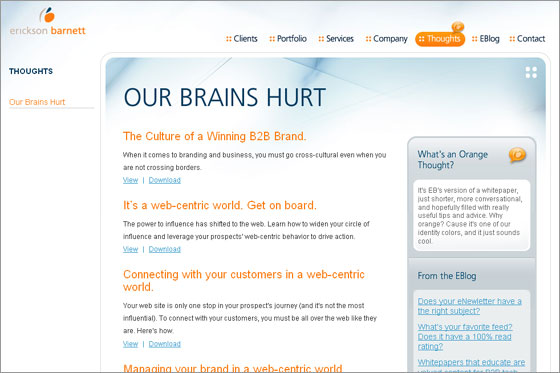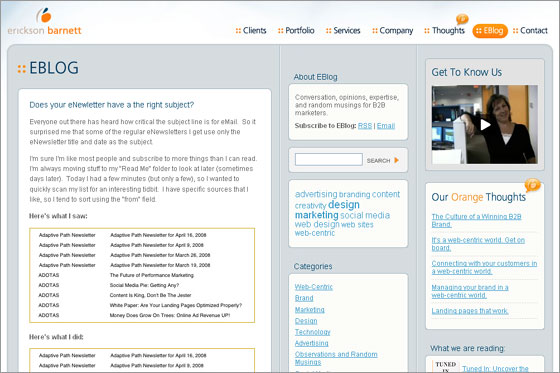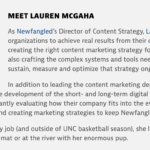I do most of my best work in the morning. In fact, I’m writing this at 7:00 am from my desk in our currently quiet, empty office. I don’t get here early to “show up” my coworkers; I do it because I know that I am going to do my best thinking and highest quality writing first thing in the morning when the office is empty, the phones aren’t ringing, and my inbox isn’t growing by the minute. Since the creation of this newsletter is central to our content strategy as a company, I have chosen to work on it at a time at which I know I’ll be able to do it to the best of my ability and without interruption. Likewise, I hope you’ve found a quiet and comfortable corner of your workplace to spend a few minutes reading this. Believe me when I tell you that considering these practical issues of time and place is critical to the success of your strategic pursuits, whether on or offline.
This month I want to focus in on the most important aspect of your online presence: Content Strategy. I’ll first briefly review what I mean by content strategy, then cover how positioning directs it, and once you’ve identified what yours should be, how to put it into practice.
What is a Content Strategy?
Put simply, content strategy involves identifying the type of content that will best enable you to communicate your positioning and achieve your online goals, then planning for the creation of that content by allocating time and resources to the effort.
%leftsidebar%
#macro:bloglist,3066,tagging#
The truth is that many firms position themselves generally and let their portfolios do all the talking. This undermines marketing by being too unclear about what a firm does best, often out of fear of losing potential business, and provides no platform on which to create content that effectively shares its thought process and strategic value. As agency consultant David Baker has written, many firms struggle with marketing because they haven’t confidently focused their positioning by identifying what kind of business they are.
A good content strategy is directed by a firm’s positioning. This means that in order to establish and execute a worthwhile content strategy for your website, you’ll need to focus in on what you do best. Once you’ve taken the step of clearly and confidently identifying what you offer, you’ll be able to determine the kind of content that will best articulate your positioning to potential clients online.
Ultimately, specialization is a good thing for marketing. If someone says to you, “How about the weather?”, you might as well reply, “Yep, we’re having some.” This conversation is going nowhere because it wasn’t specific enough to be relevant to either party. But, if that person says to you, “Hey, did you see that lightning last night?”, then you can have a conversation. In the same way, a tight positioning makes content creation strategy easier to implement and a more effective form of marketing.

A successful example of a positioning-directed content strategy is the website for Erickson Barnett. In fact, Eric recently featured them among the agency sites in the “Crit” section of his Agency Critique website. Evaluating them on the basis of positioning, platform, content and design, Eric rated their site a strong 4 out of 5.
As Eric and I discussed their site, we realized that Erickson Barnett would make a great example of a well-positioned firm with a strong content strategy for this newsletter as well. I’ll first review the areas that make their content strategy a success, then share the results of a recent conversation I had with Lee Erickson about the “cost” of a good content strategy.
First, and most importantly, Erickson Barnett clearly positions themselves as a business-to-business technology marketing firm. You can’t miss this; it’s spelled out in giant type on their homepage (see image above)! As Eric pointed out, this is not only good for the sake of clarity, but also good for the sake of honesty, noting that while “B2B technology marketing is the bread and butter of most mid-sized advertising agencies,” most firms don’t position themselves that way. Erickson Barnett is a firm comfortable with who they are and confident in what they do, which enables them to tightly position themselves without ambiguity.
The Orange Thoughts section of the website (see image below) features a group of more developed articles, which they update quarterly. While their goal is not necessarily establish themselves as thought leaders in the industry, the Orange Thoughts clearly build a strong online thought profile for the firm with a unified voice. Having read them, any prospect will know what kind of firm Erickson Barnett is; their vision, their strengths, and their unique approach.

Each article is a well-written, clearly articulated idea and composed in a way that is conducive to online reading. Often broken out into easy to follow lists, these articles all contain strong advice and actionable steps that their clients and prospects can put to use. My only critique would be that while the titles are strong from an editorial point of view, the meta title for each Orange Thought simply duplicates the page title, rather than anticipating potential search queries related to the subject of each article. This is a valuable opportunity that Erickson Barnett is passing up to improve search traffic to these pages as finding the subject of a page is the first step in search engine optimization and any internet marketing strategy needs to be heavily weighted toward search.
%leftsidebar%
#macro:bloglist,3066,tagging#
The Erickson Barnett blog (see image below) is a strong example of what any creative firm should look to achieve by blogging. By posting several times a week, Erickson Barnett can maintain a high level of quality in their posts without inundating potential readers with echoes of information they are likely to get elsewhere or derivative content.
It’s also important to point out that this is actually a blog. Fearing a lack of control but wanting to meet the expectations of a “web 2.0” audience, many firms begin publishing content under the heading of “blog” that does not actually fit the description of what a blog should be. While both allow for readers to submit comments, Erickson Barnett distinguishes between their Orange Thoughts and their blog posts for several important reasons. The Orange Thoughts are self-contained, less frequent, and more developed articles based upon internally conducted research, making for a more formal presentation. On the other hand, their blog posts are shorter and more informal, meant to comment and cumulatively articulate the firm’s point of view. These distinctions are important as they help to solidify the purpose of each type of content within Erickson Barnett’s overall strategy.

Other types of information are important to defining the purpose and presentation of a blog. These include keyword categorization of posts, tagging and a visual tag cloud, various sharing options, a blog-specific search tool, and a list of links to related or suggested material. On their blog, you can quickly scan and see what topics are written about, what books their team is reading, and what other blogs they recommend. This approach allows Erickson Barnett to use the blog to express a more subtle but comprehensive point of view- one which should become clearer and stronger as more and more content is created.
Lastly, the ability for readers to comment on posts is essential. The primary point of the blog format within a firm’s content strategy is to connect with clients and prospects. Allowing for comments is a great way to receive feedback and build trust. However, participation of this sort is not easy to come by. While A-list bloggers get hundreds or thousands of comments per post, most blogs get few to none. But, don’t let a lack of comments dissuade you from persevering with your blog. It takes time and hard work to develop a community around a blog. With that in mind, Erickson Barnett’s relatively young blog is doing quite well by getting a comment or two on most posts.
%leftsidebar%
#macro:bloglist,3066,tagging#

In a way, Erickson Barnett’s content strategy appears to be pretty simple: Feature some videos, write a more developed article every few months, keep a blog- piece of cake, right? Wrong. Even a content strategy as apparently simple as this takes a lot of hard work and comes at a cost. I recently spent some time speaking with Lee Erickson (pictured at right), co-founder and President of the firm, about what kind of effort is needed to achieve a worthwhile content strategy.
As I mentioned before, Erickson Barnett started by taking a close look a their positioning. “We started by narrowing our positioning to B2B only and becoming experts in B2B marketing,” Erickson told me. In taking this step, they were able to clearly outline what decisions needed to be made internally to support the content strategy that best fit their positioning. As a result, Erickson moved out of account management and dedicated herself full time to content creation, which is divided among doing research, blogging, and working on the Orange Thoughts articles.
“Content is the hardest thing to do. It has to come from the top down. If management doesn’t believe in it, then client work will always come first,” she said. Erickson knew that the success of their content strategy would depend upon the level of importance it had internally, so she redefined her role around their content strategy rather than “moonlighting” as company blogger and strategist. By delegating some research and writing, she is also able to us the creation of the Orange Thoughts as an opportunity to mentor junior staff members and identify those more inclined toward strategic thinking.
Erickson Barnett also took a slower approach to blogging. In fact, they spent an entire year developing their blog internally before they made any of it public. Erickson advises agencies to “blog internally as a closed blog first. You need to practice, and you need to know who’s in and who’s not.” By spending this kind of time developing their approach to blogging, they were able to find a unified voice and identify and commit to a particular goal for the blog, rather than let it turn in to an ineffective free-for-all. In fact, she pointed out that they had initially allowed for more fun “check out this cool thing” posts, but eventually removed them after deciding that the blog’s primary purpose was to “let visitors know how we thought.” They now guard this position with a conservative and measured approach to their writing, and a committed schedule that requires at least 1 post every 2-3 days, a weekly post from their analytics team, and a poll every Friday.
Out of their 14 employees, their goal is to have 3-4 bloggers actively participating. Keeping the number of bloggers low ensures that the responsibility is taken seriously. As Erickson points out, blogging needs to be done by a dedicated resource and needs to be part of their actual job description. With planned time and dedicated resources, she concluded that the blog both “keeps the company aware of it’s main goal and maintains an overall discipline for the staff.”
Lee also emphasizes the difficulty of maintaining a good content strategy. It obviously takes dedication and diligence to get it started, but it requires accountability to keep it going. While this can come from allocating full-time resources to the effort, she also noted that committing to things like speaking engagements motivated her entire team to get their household in order. “It’s just like having company over,” she remarked, “then the house get’s cleaned.” Knowing that, after an event, their website’s visibility would increase provided strong motivation to make sure that the content was saying what they wanted it to say. These types of accountability measures will vary from firm to firm, but make sure you find yours as a means of maintaining your strategy.
Your content strategy is not something to be taken lightly. One thing that became clear after spending some time with Lee Erickson is that the content visible on the Erickson Barnett website is just the tip of a much larger content strategy iceberg. Building a strong foundation for your strategy will require a serious commitment to refining your positioning, planning an approach, dedicating resources and persevering long enough to see results.


